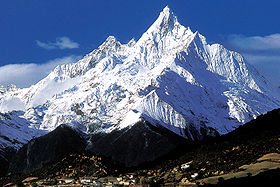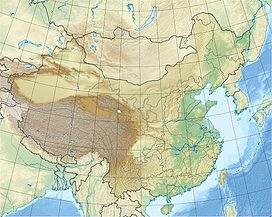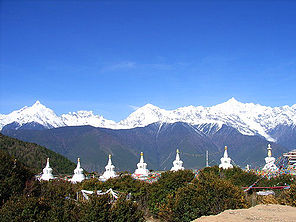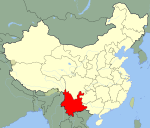- Kawagarbo
-
Kawagarbo 
Kabagarbo PeakElevation 6,740 m (22,113 ft) [1][2] Prominence 2,232 m (7,323 ft) [2] Listing Ultra Location Location in China Location Tibet/Yunnan, China Range Meili Xueshan, Hengduan Shan Coordinates 28°26′18″N 98°41′00″E / 28.43833°N 98.6833333°ECoordinates: 28°26′18″N 98°41′00″E / 28.43833°N 98.6833333°E[2] Climbing First ascent unclimbed (as of 2003)[1] Kawa Garbo (Tibetan: ཁ་བ་དཀར་པོ།, ZYPY: Kawagarbo; also transcribed as Kawadgarbo, Khawakarpo, Moirig Kawagarbo, Khawa Karpo or Kha-Kar-Po), as it is known by local residents and pilgrims, or Kawagebo Peak (Chinese: 卡瓦格博), is the highest mountain in Yunnan, China.[2] It is located in Weixi Lisu Autonomous County in Diqing Prefecture on the border with Tibet, and near the border with Myanmar. It rises about 20 kilometres (12 mi) west of Diqing, which lies on the China National Highway 214. It was previously in the Tibetan province of Kham until its incorporation into China in 1950. This mountain is often referred to as Nyainqênkawagarbo to show its saredness.
Contents
Geography
Kawakarpo is the high point of the Meili Xue Shan (梅里雪山 or Meili Snow Mountain), a small subrange of the Hengduan Shan, the major north-south trending complex of mountains covering the region where Tibet, Yunnan, Sichuan, and Myanmar converge. The Meili Xueshan forms part of the divide between the upper Salween (Nujiang) and Mekong (Lancangjiang) rivers.
The Meili Xueshan has over 20 peaks with permanent snow cover, including six peaks over 6,000 m (19,700 ft). The highest portion of the range is in the north, although Kawakarpo is centrally located. The range rises high over the deeply incised valleys to the east and west, leading to dramatic relief. The range is highly affected by the monsoon, leading to especially unstable snow conditions, which have affected climbing attempts (see below).[1]
Kawakarpo is one of the most sacred mountains for Tibetan Buddhism as the spiritual home of a warrior god which pre-existed Buddhism's arrival in Tibet.[3] It is visited by 20,000 pilgrims each year;[4] many pilgrims circumambulate the peak, an arduous 240 km (150 mi) trek.
Tibetans believe the warrior god will leave them if human sets foot on the peak of Kawakarpo, making the ground unholy. Disasters will follow as they lose god's protection.
Climbing history
The first attempt on Kawakarpo was made in 1987 by a party from the Joetsu Alpine Club of Japan.
In the winter of 1990-91 a group from the Academic Alpine Club of Kyoto University attempted the peak in conjunction with a Chinese group. Their activity caused heavy protests from the local Tibetan community due to the mountain's cultural and religious significance. On 3 January 1991, a nighttime avalanche killed all seventeen members of the expedition, in one of the most deadly mountaineering accidents in history. The Kyoto club returned in 1996 to make another unsuccessful attempt.[1]
American expeditions, led by Nicholas Clinch, visited the range in 1988, 1989, 1992, and 1993, attempting other major peaks, but were unsuccessful.
In 2001, local government passed laws banning all future climbing attempts on cultural and religious grounds. As of 2010, none of the significant peaks of the range have been successfully climbed.[1]
See also
- Three Parallel Rivers of Yunnan Protected Areas - a UNESCO World Heritage Site which also includes the Baima-Meili Snow Mountain Reserve.
References
- ^ a b c d e Tamotsu Nakamura, "East of the Himalaya", American Alpine Journal, 2003, pp. 142-145. Online version: East of the Himalaya (PDF)[dead link]
- ^ a b c d "Tibetan ultra-prominent peaks". peaklist.org. http://www.peaklist.org/WWlists/ultras/china1.html. Retrieved 2009-03-27.
- ^ Bill McQuay (2006-01-23). "The Mountain Home of a Warrior God". National Public Radio. http://www.npr.org/templates/story/story.php?storyId=5163809. Retrieved 2009-03-27.
- ^ Connie Rogers (2005-04-28). "Walking the Sacred Steps of Kawakarpo". International Herald Tribune. http://www.nytimes.com/2005/04/27/travel/27iht-tryun.html. Retrieved 2009-03-27.
Categories:- Geography of Yunnan
- Mountains of China
- Mountains of Tibet
- Tibetan Buddhist places
- Tourism in Yunnan
Wikimedia Foundation. 2010.



